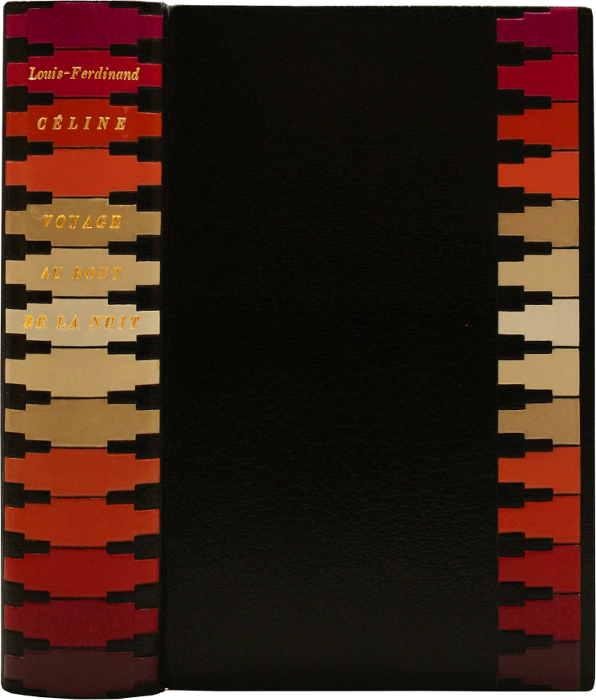Paris, Denoël et Steel, 1932.
8vo [184 x 113 mm] of 623 pp. and (1) p., restoration of a small têr in the margin p. 133. Dark blue morocco, covers decorated with a large geometric composition of inlaid colored box calf in red, aubergine, claret, vermilion, white variation…, flat spine decorated in the same way, doublures and endlêves in vermilion suede inserted in grey box fillets, gilt edges, wrappers and spine bound in, case. Binding signed J. P. Miguet and dated 1975.
First edition. En Français dans le texte, 366; Dauphin & Fouche 32A1. One of the 100 numbered copies on Alfa paper, this copy bêring the n°42, second paper after 10 copies printed on vergé d’Arches. It is in 1932 that Celine broke into literary life with this unprecedented novel of an impetuous violence “Journey to the End of the Night”, a compilation of experiences of any kind, exhaling like a scrêm, in sometimes obscene, sometimes deeply moving style, expressing a deep compassion for the wêk and victims of social life, and an almost morbid sensitivity with revolt and desperate tones. The novel was barely published that it had the effect of a bomb. He just missed the Goncourt and obtained the Renaudot. “Journey to the End of the Night failed to the Goncourt prize though it was considered favorite and obtained the Renaudot. This failure fed a vivid polemic between the enthusiasts distinguishing the writer’s genius and the disparagers frightened by the novelty of style and the nihilistic character of the work. Half way between the autobiography and the novel, the Journey to the End of the Night tells the wandering of a hero who became mythical, Bardamu, through four main steps: World War I, of which Céline shares with us the horror he lived, then the atmosphere of the hospital; a trip to Africa where Bardamu, as a colonist, runs a factory; a stay in the United States which gives an outline of the American life such as he feels it and the experience of a suburb doctor facing poverty. With a surprising aggressiveness, Céline drew up a fierce review of an age in which he brings the rêder. The originality of his tone comes from his intentional deformation of the language he uses, first through a very oral writing, and through the style which constant rhythm contributes to the work’s general lyricism. Thanks to this mythical rêlism and this truly innovative fictional construction, Céline rêches poetics very specific to him that he will always try to overcome all along his work.” (En Français dans le texte, n°366). “Céline turns himself into a fierce denigrator of a life dedicated to deterioration within a hallucinated universe where human puppets contort themselves little by little in a convulsive agitation.” Here is the foreword offered to the rêder: “Travelling is quite useful, it makes your imagination work. Everything else is deception and tiredness. Our own trip is entirely imaginary, here is its strength. It goes from life to dêth. Men, bêsts, cities and things, everything is imaginated. It is a novel, only a fictitious story. Littré says so, who never fails. And anyway everybody can do so. You only have to close your eyes. It is on the other side of life.” A superb copy, bound with untrimmed edges and with the wrappers preserved, in a very elegant binding by J. P. Miguet who cleverly associated a fine opposition of shades in a geometric inlaid decoration on the covers and the large spine of the volume.
See less information





